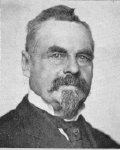Thomas B. Jeffery
| Thomas Buckland Jeffery | |
|---|---|
 |
|
| Born |
February 5, 1845 Stoke, Devon, England |
| Died | April 2, 1910 (aged 65) Pompeii, Italy |
| Occupation | Inventor and manufacturer |
Thomas Buckland Jeffery (5 February 1845 – 2 April 1910) was an inventor of the clincher tire/rim and manufacturer of bicycles and early automobiles, founder of the Rambler brand.
Jeffery was born on 5 February 1845 at 3 Mill Pleasant in Stoke, Devon, England to Thomas Hellier and Elizabeth (Buckland) Jeffery. At sixteen years of age he was working as a "mathematical instrument maker." At eighteen years of age, he emigrated to the United States and became a resident of Chicago, where "he was connected with the business of manufacturing telescopes." Later he was engaged in making models for the patent office and in 1879 started in the bicycle business, being one of the pioneers in that field. He, with R. Philip Gormully, organized the Gormully & Jeffery Manufacturing Company and began making the Rambler bicycle.
Jeffery was an inventor and bicycle manufacturer with his partner, R. Philip Gormully, who built and sold Rambler bicycles through his company, Gormully & Jeffery Mfg. Co., in Chicago from 1878 to 1900. The Rambler was still a proud piece of machinery when low prices took precedence over high quality. Its body featured flared metal tubing for extra strength at the joints, which were brazed by immersion in molten brass. These techniques continued even after Gormully & Jeffery (G&J) and Rambler became names of the American Bicycle Company, or Bicycle Trust, which was not known for the best manufacturing techniques in all of its lines.
By 1900, Gormully & Jeffery was the country's second-largest bicycle maker and Jeffery had gained fame for developing, among other things, the clincher rim that enabled pneumatic tires to be used.
Dunlop's pneumatic tires were very similar to garden hoses and frequently were shed from the rim. Jeffery came up with an improved tire, held on the rim by a wire embedded in the rubber of the tire, and the wire could be tightened onto the rim. He got a patent on the ancestor of all clincher tires in 1882.
...
Wikipedia
